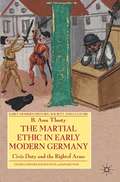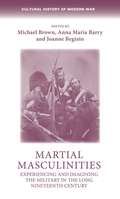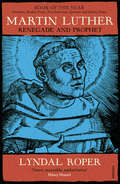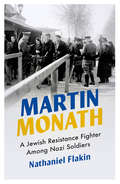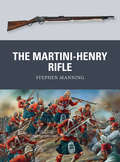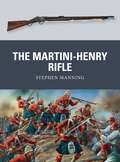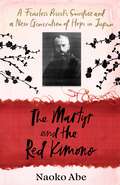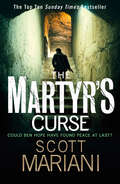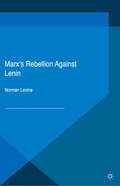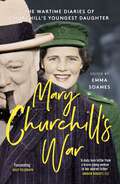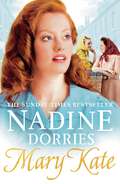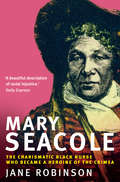- Table View
- List View
Martha's Journey
by Maureen LeeA powerful First World War story of a woman's quest for justice, from the bestselling author of NOTHING LASTS FOREVER and THE LEAVING OF LIVERPOOL.Liverpool 1915. Martha Rossi lives in a tenement with her husband and their five children. Despite working all the hours she can, the family don't have much to get by on. When Martha's fourteen-year-old son, Joe, proudly enlists to fight for his country just to earn his mother an extra shilling, Martha is horrified. She realises the government is turning a blind eye to the scores of young boys who are joining the army. Despite her pleas and protests, Joe is dispatched to France within weeks.Unbeknown to them all, Joe's act of selfless heroism will have huge implications for Martha and all the family. As the dreaded telegrams begin to arrive from the front in France, mothers' hearts are broken across the country. Spurred on by grief of her own, Martha Rossi begins a quest that will take her right to the doors of No. 10 Downing Street. Martha's journey there will be a tough one, but with courage and the support of her friends and family, it will be the most important undertaking of her life.
Martial Aesthetics: How War Became an Art Form
by Anders Engberg-PedersenThe twenty-first century has witnessed a pervasive militarization of aesthetics with Western military institutions co-opting the creative worldmaking of art and merging it with the destructive forces of warfare. In Martial Aesthetics, Anders Engberg-Pedersen examines the origins of this unlikely merger, showing that today's creative warfare is merely the extension of a historical development that began long ago. Indeed, the emergence of martial aesthetics harkens back to a series of inventions, ideas, and debates in the eighteenth and early nineteenth century. Already then, military thinkers and inventors adopted ideas from the field of aesthetics about the nature, purpose, and force of art and retooled them into innovative military technologies and a new theory that conceptualized war not merely as a practical art, but as an aesthetic art form. This book shows how military discourses and early war media such as star charts, horoscopes, and the Prussian wargame were entangled with ideas of creativity, genius, and possible worlds in philosophy and aesthetic theory (by thinkers such as Leibniz, Baumgarten, Kant, and Schiller) in order to trace the emergence of martial aesthetics. Adopting an approach that is simultaneously historical and theoretical, Engberg-Pedersen presents a new frame for understanding war in the twenty-first century.
Martial Aesthetics: How War Became an Art Form
by Anders Engberg-PedersenThe twenty-first century has witnessed a pervasive militarization of aesthetics with Western military institutions co-opting the creative worldmaking of art and merging it with the destructive forces of warfare. In Martial Aesthetics, Anders Engberg-Pedersen examines the origins of this unlikely merger, showing that today's creative warfare is merely the extension of a historical development that began long ago. Indeed, the emergence of martial aesthetics harkens back to a series of inventions, ideas, and debates in the eighteenth and early nineteenth century. Already then, military thinkers and inventors adopted ideas from the field of aesthetics about the nature, purpose, and force of art and retooled them into innovative military technologies and a new theory that conceptualized war not merely as a practical art, but as an aesthetic art form. This book shows how military discourses and early war media such as star charts, horoscopes, and the Prussian wargame were entangled with ideas of creativity, genius, and possible worlds in philosophy and aesthetic theory (by thinkers such as Leibniz, Baumgarten, Kant, and Schiller) in order to trace the emergence of martial aesthetics. Adopting an approach that is simultaneously historical and theoretical, Engberg-Pedersen presents a new frame for understanding war in the twenty-first century.
The Martial Ethic in Early Modern Germany: Civic Duty and the Right of Arms (Early Modern History: Society and Culture)
by B. TlustyFor German townsmen, life during the sixteenth and seventeenth centuries was characterized by a culture of arms, with urban citizenry representing the armed power of the state. This book investigates how men were socialized to the martial ethic from all sides, and how masculine identity was confirmed with blades and guns.
Martial masculinities: Experiencing and imagining the military in the long nineteenth century (Cultural History of Modern War)
by Michael Brown Joanne Begiato Anna Maria BarryThis collection explores the role of martial masculinities in shaping nineteenth-century British culture and society in a period framed by two of the greatest wars the world had ever known. It offers a fresh, interdisciplinary perspective on an emerging field of study and draws on historical, literary, visual and musical sources to demonstrate the centrality of the military and its masculine dimensions in the shaping of Victorian and Edwardian personal and national identities. Focusing on both the experience of military service and its imaginative forms, it examines such topics as bodies and habits, families and domesticity, heroism and chivalry, religion and militarism, and youth and fantasy. This collection will be required reading for anyone interested in the cultures of war and masculinity in the long nineteenth century.
Martial masculinities: Experiencing and imagining the military in the long nineteenth century (Cultural History of Modern War)
by Michael Brown Joanne Begiato Anna Maria BarryThis collection explores the role of martial masculinities in shaping nineteenth-century British culture and society in a period framed by two of the greatest wars the world had ever known. It offers a fresh, interdisciplinary perspective on an emerging field of study and draws on historical, literary, visual and musical sources to demonstrate the centrality of the military and its masculine dimensions in the shaping of Victorian and Edwardian personal and national identities. Focusing on both the experience of military service and its imaginative forms, it examines such topics as bodies and habits, families and domesticity, heroism and chivalry, religion and militarism, and youth and fantasy. This collection will be required reading for anyone interested in the cultures of war and masculinity in the long nineteenth century.
Martin B-26 Marauder (Air Vanguard #4)
by Martyn ChorltonOne of the most underrated medium bombers of the Second World War, the Martin B-26 Marauder never fully managed to shake off an underserved early reputation as a dangerous aircraft to fly. Deemed superior to all other designs on the table at the time, almost a 1,000 had been ordered before the aircraft first took to the air November 1940. From late 1941 the first B-26s became operational in the Pacific, followed by the Mediterranean, but it is in the European theatre that the type was most prolific. It was particularly during the Normandy Landings and later the advance beyond 'the bulge' into Germany, were the B-26s medium level tactical ability shone through. The Marauder also served with the RAF, SAAF and Free French Air Force in the Mediterranean and also as part of the little credited Balkan Air Force in support of Tito's Partisans in Yugoslavia. Sadly the B-26 was unfairly treated at the beginning of its career and even more so at the end as many of the 5,200+ aircraft built were scrapped only days after the end of the war. A great aircraft in many respects the B-26 deserves to be in a better place.
Martin B-26 Marauder (Air Vanguard #4)
by Henry Morshead Martyn Chorlton Adam ToobyOne of the most underrated medium bombers of the Second World War, the Martin B-26 Marauder never fully managed to shake off an underserved early reputation as a dangerous aircraft to fly. Deemed superior to all other designs on the table at the time, almost a 1,000 had been ordered before the aircraft first took to the air November 1940. From late 1941 the first B-26s became operational in the Pacific, followed by the Mediterranean, but it is in the European theatre that the type was most prolific. It was particularly during the Normandy Landings and later the advance beyond 'the bulge' into Germany, were the B-26s medium level tactical ability shone through. The Marauder also served with the RAF, SAAF and Free French Air Force in the Mediterranean and also as part of the little credited Balkan Air Force in support of Tito's Partisans in Yugoslavia. Sadly the B-26 was unfairly treated at the beginning of its career and even more so at the end as many of the 5,200+ aircraft built were scrapped only days after the end of the war. A great aircraft in many respects the B-26 deserves to be in a better place.
Martin Luther: Renegade And Prophet
by Lyndal RoperSHORTLISTED FOR THE WOLFSON HISTORY PRIZE 2017 SHORTLISTED FOR THE ELIZABETH LONGFORD PRIZE 2017'A magnificent study of one of history's most compelling and divisive figures' Richard J. EvansWhen Martin Luther nailed a sheet of paper to the church door of a small university town in 1517, he set off a process that changed the Western world for ever.Within a few years Luther’s ideas had spread like wildfire. His attempts to reform Christianity by returning it to its biblical roots split the Western Church, divided Europe and polarised people’s beliefs, leading to religious persecution, social unrest and war; and in the long run his ideas would help break the grip of religion on every sphere of life.Yet Luther was a deeply flawed human being: a fervent believer tormented by spiritual doubts; a prolific writer whose translation of the Bible would shape the German language yet whose attacks on his opponents were vicious and foul-mouthed; a married ex-monk who liberated human sexuality from the stigma of sin but who insisted that women should know their place; a religious fundamentalist, Jew-hater and political reactionary who called ‘for the private and public murder of the peasants’ who had risen against their lords in response to his teaching. And perhaps surprisingly, the man who helped create in the modern world was not modern himself: for him the devil was not a figure of speech but a real, physical presence.As an acclaimed historian, Lyndal Roper explains how Luther’s impact can only be understood against the background of the times. As a brilliant biographer, she gives us the flesh-and-blood figure. She reveals the often contradictory psychological forces that drove Luther forward and the dynamics they unleashed, which turned a small act of protest into a battle against the power of the Church.A New Statesman, Spectator, History Today, Guardian and Sunday Times Book of the Year
Martin Monath: A Jewish Resistance Fighter Among Nazi Soldiers (Revolutionary Lives)
by Nathaniel FlakinA dramatisation of Martin Monath's short life (1913-1944) would need little artistic embellishment; his identity shrouded in mystery, and executed by the Gestapo - twice - the historical record reads like a detective novel.Pieced together for the first time by Wladek Flakin, this biography tells the story of the Jewish socialist and editor of Arbeiter und Soldat ('Worker and Soldier'), and his efforts to turn German rank-and-file soldiers against their Nazi officers in occupied France. Born in Berlin in 1913, Martin Monath was a child of war and revolution. In the 1930s he became a leader of the socialist Zionist youth organisation Hashomer Hatzair in Germany. Fleeing from Berlin to Brussels in 1939, he joined the underground Trotskyist party led by Abraham Leon, and soon became a leading member of the Fourth International in Europe. His relocation to Paris in 1943 saw the birth of Arbeiter und Soldat and his work organising illegal cells of German soldiers for a revolutionary struggle against the Nazis.Drawing on extensive archival research, Flakin uses letters, testimonies and unpublished documents to bring Monath's story to life - weaving a tale rich with conviction and betrayal, ideology and espionage.
Martin Monath: A Jewish Resistance Fighter Among Nazi Soldiers (Revolutionary Lives)
by Nathaniel FlakinA dramatisation of Martin Monath's short life (1913-1944) would need little artistic embellishment; his identity shrouded in mystery, and executed by the Gestapo - twice - the historical record reads like a detective novel.Pieced together for the first time by Wladek Flakin, this biography tells the story of the Jewish socialist and editor of Arbeiter und Soldat ('Worker and Soldier'), and his efforts to turn German rank-and-file soldiers against their Nazi officers in occupied France. Born in Berlin in 1913, Martin Monath was a child of war and revolution. In the 1930s he became a leader of the socialist Zionist youth organisation Hashomer Hatzair in Germany. Fleeing from Berlin to Brussels in 1939, he joined the underground Trotskyist party led by Abraham Leon, and soon became a leading member of the Fourth International in Europe. His relocation to Paris in 1943 saw the birth of Arbeiter und Soldat and his work organising illegal cells of German soldiers for a revolutionary struggle against the Nazis.Drawing on extensive archival research, Flakin uses letters, testimonies and unpublished documents to bring Monath's story to life - weaving a tale rich with conviction and betrayal, ideology and espionage.
The Martini-Henry Rifle (Weapon #26)
by Peter Dennis Dr Stephen ManningThe breech-loading, single-shot .458in Martini-Henry rifle has become a symbol of both the Anglo-Zulu War of 1879 and the numerous battles in Egypt and the Sudan in 1884–85, but continued to be used by both British and colonial troops well into the 20th century. Its invention and introduction into British service were in direct response to the success of the Prussian Dreyse needle gun, which demonstrated that the breech-loading rifle offered faster loading, improved accuracy and superior range; significantly, the weapon could be loaded and fired from a prone position, thus offering the rifleman greater security on the battlefield. Due to the longevity of service, many Martini-Henry rifles survive today, both in museums and in private collections, and the weapon is highly prized by shooting enthusiasts. Featuring specially commissioned full-colour artwork and an array of arresting first-hand accounts and written by an authority on warfare in the Victorian era, this engaging study tells the story of the powerful Martini-Henry and its impact on the battlefield, from the Anglo-Zulu War to the opening months of World War I.
The Martini-Henry Rifle (Weapon #26)
by Peter Dennis Stephen ManningThe breech-loading, single-shot .458in Martini-Henry rifle has become a symbol of both the Anglo-Zulu War of 1879 and the numerous battles in Egypt and the Sudan in 1884–85, but continued to be used by both British and colonial troops well into the 20th century. Its invention and introduction into British service were in direct response to the success of the Prussian Dreyse needle gun, which demonstrated that the breech-loading rifle offered faster loading, improved accuracy and superior range; significantly, the weapon could be loaded and fired from a prone position, thus offering the rifleman greater security on the battlefield. Due to the longevity of service, many Martini-Henry rifles survive today, both in museums and in private collections, and the weapon is highly prized by shooting enthusiasts. Featuring specially commissioned full-colour artwork and an array of arresting first-hand accounts and written by an authority on warfare in the Victorian era, this engaging study tells the story of the powerful Martini-Henry and its impact on the battlefield, from the Anglo-Zulu War to the opening months of World War I.
The Martyr and the Red Kimono: A Fearless Priest’s Sacrifice and A New Generation of Hope in Japan
by Naoko AbeThe remarkable true story of Saint Maximilian Kolbe, and the two men in war-torn Japan whose lives he changed forever.On the 14th of August 1941, a Polish priest named Maximilian Maria Kolbe was murdered in Auschwitz.Kolbe's life had been remarkable. Fiercely intelligent and driven, he founded a movement of Catholicism and spent several years in Nagasaki, ministering to the 'hidden Christians' who had emerged after centuries of oppression. A Polish nationalist as well as a priest, he gave sanctuary to fleeing refugees and ran Poland's largest publishing operation, drawing the wrath of the Nazis. His death was no less remarkable: he volunteered to die, saving the life of a fellow prisoner.It was an act that profoundly transformed the lives of two Japanese men. Tomei Ozaki was just seventeen when the US dropped an atomic bomb on Nagasaki, destroying his home and his family. Masatoshi Asari worked on a farm in Hokkaido during the war and was haunted by the inhumane treatment of prisoners in a nearby camp. Forged in the crucible of an unforgiving war, both men drew inspiration from Kolbe's sacrifice, dedicating their lives to humanity and justice. Ozaki followed in his footsteps and became a friar. Asari created cherry trees as peace offerings.In The Martyr and the Red Kimono, award-winning author Naoko Abe weaves together a deeply moving and inspirational true story of resistance, sacrifice, guilt and atonement.
The Martyr’s Curse (Ben Hope #11)
by Scott MarianiTHE ADDICTIVE NEW THRILLER FROM THE #1 BESTSELLING AUTHOR ‘Deadly conspiracies, bone-crunching action and a tormented hero with a heart . . . packs a real punch’ Andy McDermott
Marx's Rebellion Against Lenin
by Norman LevineMarx's Rebellion Against Lenin, by negating the Leninist-Stalinist theory of dialectical materialism and tracing Marx's political philosophy to the Classical Humanism of Aristotle, overthrows the stultifying entrapment of Stalinist Bolshevism and contributes to the revitalization of Marx's method.
Mary Boleyn: 'The Great and Infamous Whore'
by Alison WeirSister to Anne Boleyn and seduced by two kings, Mary Boleyn has long been the subject of scandal and myth. Her affair with Henry VIII fuelled the shocking annulment of his marriage to Anne, and Mary is rumoured to have borne his child in secret. In this, the first full-length biography of Mary Boleyn, Alison Weir explodes much of the mythology that surrounds her subject's notoriety. Her extensive research gives us a new and detailed portrayal, revealing Mary as one of hte most misunderstood figures of the Tudor age. From the internationally bestselling author of Eleanor of Aquitaine.
Mary Churchill's War: The Wartime Diaries of Churchill's Youngest Daughter
by Emma Soames'A fascinating and intimate insight into the iconic Prime Minister's family life' TELEGRAPH 'I am not a great or important personage, but this will be the diary of an ordinary person's life in war time. Though I may never live to read it again, perhaps it may not prove altogether uninteresting as a record of my life'In 1939 seventeen-year-old Mary found herself in an extraordinary position at an extraordinary time: it was the outbreak of the Second World War and her father, Winston Churchill, had been appointed First Lord of the Admiralty; within months he would be Prime Minister.The young Mary Churchill was uniquely placed to observe this remarkable historical moment, and her diaries -- most of which have never been published -- provide a front-row view of the great events of war, as well as exchanges and intimate moments with her father. But they also capture what it was like to be a young woman during wartime. An impulsive and spirited writer, full of coming-of-age self-consciousness and joie de vivre, Mary's diaries are untrammelled by hindsight or self-censorship or nostalgia.From aid raid sirens at 10 Downing Street to seeing action with the ATS, from cocktail parties with presidents and royals to accompanying her father on key diplomatic trips, Mary's wartime diaries are full of colour, rich in historical insight, and a charming and intimate portrait of life alongside Winston Churchill.Compiled and edited by Mary's daughter, Emma Soames, in collaboration with The Churchill Archives Centre.
Mary Kate (The Tarabeg Series #2)
by Nadine DorriesDorries is the queen of the saga and she is back with a heart-wrenching, captivating new novel' Bookish Jottings. Liverpool, 1963. Mary Kate Malone is seventeen and bitterly unhappy that her father has married again after the death of her mother. On her last day at school, she decides to leave home in Tarabeg on the west coast of Ireland and head for Liverpool to find her mother's sister. But absolutely nothing goes to plan. Within hours of disembarking, she finds herself penniless and alone, with no place to stay and no idea how she will survive. Meanwhile, back in Ireland, where old sins cast long shadows, a long-buried secret is about to come to light and a day of reckoning, in the shape of a stranger from America, will set an unstoppable chain of events in motion. What readers are saying about the Tarabeg Series: 'A brilliant read, a wonderful story and I have already pre-orderd the next book' 'Great read! Nadine Dorries is a top author, love her books!' 'Did not want it to end!! Gripping, detailed... Really draws you in to the story
Mary Queen of Scots: In My End is My Beginning
by Dr James MackayIn My End Is My Beginning is the story of Mary Queen of Scots (1542–87), the tragic heroine par excellence. Queen of an unfamiliar and troubled nation when she was a week old, it was her misfortune to be a pawn in the game of international politics throughout her life. Even in the brief period from 1561 to 1567 when she was ruler of Scotland in fact as well as in name, she was beset with problems that would have defeated a much stronger, more experienced monarch. A talented poet and a charismatic leader, she contended with a treacherous, self-serving nobility, the religious ferment of the Reformation, and the political ambitions of larger and more powerful neighbours. With little real authority and few resources, Mary’s reign was successful, until her disastrous marriage to the dissolute Darnley set in motion the events that brought about her downfall. For the last 20 years of her life she was a prisoner in the hands of her cousin, Elizabeth I of England, and the subject of treacherous plots and conspiracies. A hostage to fortune, she represented a threat and a rallying-point for English Catholics. Her tragic end was inevitable. Yet her life, with all its adventurous, failures and disasters, produced the son – James – who ultimately brought about the union of Scotland and England.In the End Is My Beginning uncovers the true facts of Mary’s life in the context of Anglo-Scottish relations and shows why, after more than 400 years, she remains arguably the greatest character in popular Scottish history.
Mary Queen of Scots: And the Murder of Lord Darnley
by Alison WeirOn the night of 10 February 1567 an explosion devastated the Edinburgh residence of Henry Stewart, Lord Darnley, second husband of Mary, Queen of Scots. The noise was heard as far away as Holyrood Palace, where Queen Mary was attending a wedding masque. Those arriving at the scene of devastation found, in the garden, the naked corpses of Darnley and his valet. Neither had died in the explosion, but both bodies bore marks of strangulation. It was clear that they had been murdered and the house destroyed in an attempt to obliterate the evidence. Darnley was not a popular king-consort, but he was regarded by many as having a valid claim to the English throne. For this reason Elizabeth I had opposed his family's longstanding wish to marry him to Mary Stuart, who herself claimed to be the rightful queen of England. Alison Weir's investigation of Darnley's murder is set against one of the most dramatic periods in British history. Her conclusions will shed a brilliant new light on the actions and motives of the conspirators and, in particular, the extent of Mary's own involvement.
Mary Seacole: The Charismatic Black Nurse Who Became a Heroine of the Crimea
by Jane RobinsonThe 'Greatest Black Briton in History' triumphed over the Crimea and Victorian England. "The Times" called her a heroine, Florence Nightingale called her a brothel-keeping quack, and Queen Victoria's nephew called her, simply, 'Mammy' - Mary Seacole was one of the most eccentric and charismatic women of her era. Born at her mother's hotel in Jamaica in 1805, she became an independent 'doctress' combining the herbal remedies of her African ancestry with sound surgical techniques. On the outbreak of the Crimean War, she arrived in London desperate to join Florence Nightingale at the Front, but the authorities refused to see her. Being black, nearly 50, rather stout, and gloriously loud in every way, she was obviously unsuitable. Undaunted, Mary travelled to Balaklava under her own steam to build the 'British Hotel', just behind the lines. It was an outrageous venture, and a huge success - she became known and loved by everyone from the rank and file to the royal family. For more than a century after her death this remarkable woman was all but forgotten. This, the first full-length biography of a Victorian celebrity recently voted the greatest black Briton in history, brings Mary Seacole centre stage at last.
Marye's Heights: Fredericksburg (Battleground America Ser.)
by Victor BrooksFredericksburg was one of the most tragic battles of the Civil War. No sector was more hotly contested than the area held by Longstreet's troops and known as Marye's Heights. While the heights seemed impregnable to the charging Union troops, Longstreet's men took heavy casualties and many times felt they were on the point of being overrun. The latest Battleground America volume covers the actions, units and personalities of this key section of the Fredericksburg battlefield and describes in detail the area as it was in 1862 and the national park that occupies the site today.
Masculinity and Nationhood, 1830-1910: Constructions of Identity and Citizenship in Belgium (Genders and Sexualities in History)
by J. HoegaertsA history of what it meant to be a man, and a citizen of an emerging nation throughout the nineteenth century. This book not only relates how Belgians were taught how to move and fight, but also how they spoke and sang to express masculinity and patriotism.
MASH: A Novel About Three Army Doctors
by Richard HookerThe book behind the hit TV series and movie.The doctors and nurses who worked in the Mobile Army Surgical Hospitals (MASH) during the Korean War were well trained, dedicated, and pushed to the brink. And they were young - too young to be doing what they had to do. As Richard Hooker writes in the Foreword, 'A few flipped their lids, but most of them just raised hell, in a variety of ways and degrees.'Meet the true-life heroes and lunatics who fought in the Korean War, and experience the martini-laced mornings, marathon high jinks, sexual escapades, and that perfectly corrupt football game that every fan of the movie will remember. It's also a story of hard work and skill in the face of enormous pressure and odds. Here is where it all began - the novel that made M*A*S*H a legend.


